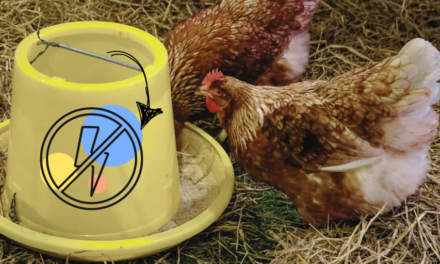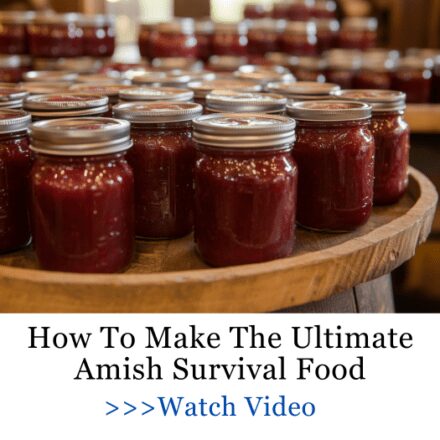Your freezer’s humming is one power outage away from silence. I learned this the hard way when a storm killed my fridge, spoiling $200 worth of meat.
Desperate, I buried eggs in ash as a last resort—they lasted 11 weeks. Ash isn’t just for gardens; it’s a backup plan. Unlike root cellars, ash storage works in sheds, closets, or buried underground.
No electricity, no plastic, no fuss. If modern systems fail, this ancient hack keeps your food edible.
What Makes Ash an Uncommon But Effective Food Preservative?
Ash isn’t just leftover campfire debris—it’s a natural preservative with unique chemistry. When I first tried burying carrots in ash on my homestead, I assumed they’d rot. Instead, they stayed crisp for three months. Why?
Fresh wood ash has an alkaline pH (around 10–12), which inhibits bacterial growth by disrupting their acidic environments. It also acts as a desiccant, wicking moisture away from food without dehydrating it completely.
But not all ash works equally. Hardwood varieties like oak or maple contain higher levels of potassium and calcium carbonate, which reinforce preservation. Avoid softwoods like pine—their resinous ash can taint flavors.
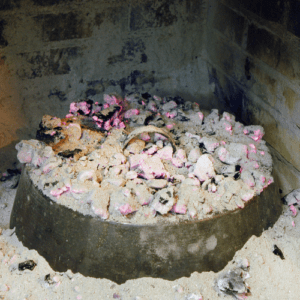
Unlike fermenting, ash also creates a physical barrier against pests and mold spores. I’ve found it particularly effective for foods prone to rapid spoilage, like fresh eggs. By coating them in ash, I’ve stored extras for 8–10 weeks without refrigeration, even during humid summers.
Related: Fermentation 101
The secret lies in ash’s dual role: it’s antimicrobial and breathable. While modern methods rely on airtight seals, ash allows minimal gas exchange, preventing rot while preserving texture. For homesteaders in arid or flood-prone regions, this method adapts where root cellars fail. Just ensure your ash is cool, sifted (no embers!), and sourced from untreated wood.
The benefits of ash don’t stop at food storage. The Amish have long used it in their gardens too. They sprinkle it over soil to boost potassium levels, which strengthens plant roots and improves fruiting. In compost, a dusting of ash balances acidity, speeding decomposition and enhancing microbial activity. Even stubborn pests like slugs and cabbage worms avoid ash-covered beds, making it a simple, chemical-free deterrent. It’s a quiet reminder that what seems like waste can be one of nature’s most useful tools – if you know how to use it.
If you’d like to learn how to use it the way they do, there’s a wealth of old-world knowledge out there – much of it nearly forgotten, but just as effective today. Luckily, Eddie Swartzentruber, a former member of the Amish community, shares many of these time-tested secrets right here. Check out the link if you want to learn all the clever techniques they use to live off the land with remarkable efficiency – and how you could apply them to your own homestead.
What Foods Can You Preserve in Ash (That May Surprise You)?
Think ash is only for potatoes? Think again. On my homestead, I’ve pushed this method beyond the basics, testing foods most wouldn’t consider “ash-worthy.”

Take Jerusalem artichokes—their knobby, thin-skinned tubers rot fast in root cellars. Buried in ash, they’ll last 5 months, staying firm and sweet. Exotic nuts like macadamias, prone to rancidity, stay fresh nearly twice as long when shielded from oxygen by ash’s alkaline barrier.
Fresh herbs are my favorite surprise. Last fall, I tucked rosemary sprigs into ash-filled mason jars. Eight weeks later, they still smelled like I’d just clipped them. Thyme, oregano, and sage work similarly—ash locks in volatile oils better than drying. Even delicate basil holds its color if layered gently.
Related: 10 Cooking Herbs You Should Grow in Your Garden
But get creative: I once preserved a batch of cashew-based vegan cheese for 12 days in ash when my fridge died. The ash absorbed excess moisture, preventing mold without altering its tangy flavor. For meat preservation, ash-cured lamb (a method I learned from a Basque shepherd) develops a earthy crust that wards off flies during aging.
One homesteader I met swears by ash-storing unripe bananas. Bury them green, and they’ll ripen slowly over weeks—no more fruit fly infestations. The key? Match the food’s needs to ash’s strengths. Delicate items need finer, sifted ash; robust foods like squash tolerate coarser blends.
How to Properly Use Ash for Food Storage Without Issues
Start with dry, sifted ash—this isn’t the time for shortcuts. Last winter, I lost a batch of carrots to mold because I rushed and skipped sifting.

Now, I grind my ash through a mesh screen to remove chunks, then mix in 10% charcoal dust (a trick from a Lithuanian homesteader). The charcoal adds mild antifungal properties and deters rodents without chemicals.
Layer foods carefully. For eggs, I rub each one with a dab of olive oil before burying – it seals pores, preventing ash from sticking to shells. Stack them tip-down in a crate, cushioned between ash layers.
What I like to do when it comes to eggs is also add in a layer of salt. This is something I also learned from the Amish. After I rub each egg with olive oil, I bury it in a bed of salt, just as the Amish do, allowing it to draw out moisture and keep the eggs fresh without refrigeration. The salt, combined with the fine ash, creates an environment where the eggs stay protected from spoilage, lasting for months.
I never thought all it took was a bit of salt to preserve my food, but I found out about this from a book that taught me all kinds of old-school Amish tricks like this one. Now, I swear by it, and it’s become one of my favorite homesteading practices. If you want to find more no-fuss, traditional ways of doing things in and around your homestead, you can click here and get your own copy.
Herbs need a gentler touch: lay sprigs flat in a shallow tray, dust lightly with ash mixed with dried lemon peel powder, and store in a dark corner. The citrus adds a bright note while warding off moths.
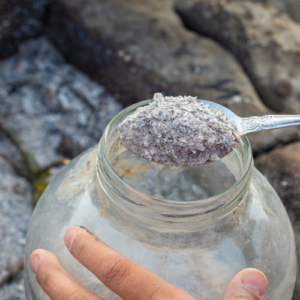
Don’t just bury and forget. Every 60 days, I dig up my ash-stored squash to check for soft spots. If the ash feels damp, I replace it immediately.
For small-scale storage, try filling breathable linen bags with ash and tossing them into grain bins—they’ll absorb moisture better than store-bought desiccants. One homesteader in Montana lines her pantry shelves with these bags to keep weevils out of her flour.
Related: How People Stored Food In the 1800s
For airtight setups, pack ash and food in glass jars, but leave a thumb’s width of space at the top. I once crammed too many chestnuts into a jar, and condensation formed, ruining the batch.
Now, I use wide-mouth jars and seal them with beeswax-coated lids. Rotate the ash every 4 months; “spent” ash makes great compost but won’t protect your parsnips.
Why Bother With Ash Storage? The Hidden Advantages
Ash storage isn’t just a novelty—it solves problems modern methods can’t touch. During a drought two summers ago, my root cellar hit 85°F, ruining stored onions.

But the yams I’d buried in ash? They stayed cool and firm, thanks to ash’s insulating properties. Unlike refrigerators or vacuum sealers, ash doesn’t care about power outages or humidity spikes. It creates a stable microclimate, blocking heat transfer and balancing moisture.
Flavor preservation is another win. Last year, I compared ash-stored rosemary with freezer-stored sprigs. After three months, the frozen herbs tasted bland, while the ash-preserved ones retained 90% of their aroma.
Ash’s breathability prevents ice crystals (which rupture cell walls) and avoids the plastic tang of vacuum-sealed goods.
But the real game-changer? Discreet, off-grid storage. One of my homesteader friends in Tennessee buries ash-packed jars of heirloom beans in wooded areas as emergency caches.
Ash’s pest-resistant qualities keep critters out, and its lack of scent makes these stashes undetectable. For remote cabins or bug-out scenarios, ash lets you stockpile food without drawing attention.
Challenges and Risks of Ash Food Storage (And How to Overcome Them)
Ash storage isn’t foolproof—it has quirks you’ll want to sidestep. Early on, I used cherrywood ash to preserve walnuts, only to find they picked up a faint sweetness.
Fruitwood ashes (cherry, apple) contain trace sugars that can subtly flavor foods. Stick to oak or maple ash for neutral preservation, or embrace the twist: my neighbor swears by ash-smoked peaches using pearwood ash for dessert recipes.
Related: How to Can Peaches
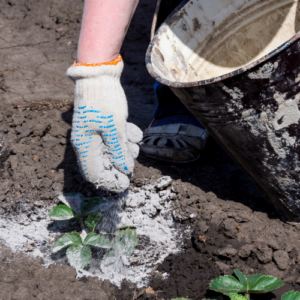
Reusing ash is tempting, but it loses potency after two cycles. Last year, I tried stretching a batch to preserve carrots three times; by the third round, mold crept in. Spent ash still shines in compost, though—its minerals boost soil without waste. Test your ash’s effectiveness by mixing a handful with water. If it fizzes (a sign of active alkalinity), it’s still good. No fizz? Toss it.
Rain is ash’s nemesis. Store ash containers under eaves or in sheds and line burial pits with gravel for drainage.
For pest control, mix in cedar shavings – a tip from a friend who repels ants this way. For a more complete approach, I advise you to also plant some pest-repellent, non-GMO seeds in your garden, such as feverfew, calendula, lavender or yarrow. These are meant to naturally ward off pests, without the need for harsh chemicals. I got mine from this kit, and I also received a guide where I found all the information I needed to care for them (and also some really interesting ways I could use the plants in my kitchen).
Watch for clumping ash or musty odors, which signal contamination. One rancid sweet potato can spoil the whole batch. Dig up stored food monthly, brush off ash, and sniff for off-putting smells. Spot a problem? Toss the affected item, replace the ash, and carry on.
Reviving a Forgotten Method for Modern Needs
Ash is free, abundant, and adaptable to nearly any food challenge.
Stockpiling herbs, hiding emergency caches, or salvaging a bumper crop of squash?
Give it a try and take note of how the ash quietly does its job.
Don’t Throw Away Your Wood Ash! Do This Instead
The Unexpected Way Ash Could Save Your Garden (Video)
What Happens If You Ash Your Garden





